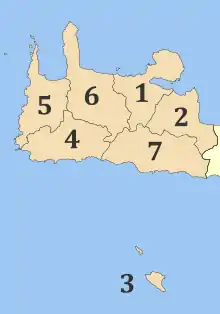Chania (regional unit)
Chania (Greek: Περιφερειακή ενότητα Χανίων), also spelled Hania, is one of the four regional units of Crete; it covers the westernmost quarter of the island. Its capital is the city of Chania. Chania borders only one other regional unit: that of Rethymno to the east. The western part of Crete is bounded to the north by the Cretan Sea(part of the Aegean Sea) and to the west and south by the Mediterranean Sea and Libyan Sea. The regional unit also includes the southernmost island of Europe, Gavdos.
Chania
Περιφερειακή ενότητα Χανίων | |
|---|---|
 Municipalities of Chania regional unit | |
 Chania regional unit within Greece | |
| Coordinates: 35°25′N 23°55′E | |
| Country | Greece |
| Region | Crete |
| Capital | Chania |
| Area | |
| • Total | 2,376 km2 (917 sq mi) |
| Population (2011) | |
| • Total | 156,585 |
| • Density | 66/km2 (170/sq mi) |
| Time zone | UTC+2 |
| • Summer (DST) | UTC+3 (EEST) |
| Postal codes | 73x xx, 740 55 |
| Area codes | 282x0, 28310 |
| ISO 3166 code | GR-94 |
| Car plates | ΧΝ |
| Website | www |
Geography
Chania regional unit, often informally termed 'Western Crete', is a part of the island which includes the capital Chania, and the districts of Platanias and Apokoronas in the north, and Sfakia and Selino in the far south west corner. Other towns in the Chania prefecture include Hora Sfakion, Kissamos, Palaiochora, Maleme, Vryses, Vamos, Georgioupolis and Kalives.
The natural park of Samariá Gorge, a tourist attraction and a refuge for the rare Cretan wild goat or kri-kri, is in the South of the regional unit.
The White Mountains or Lefka Ori, through which the Samaria, Aradena, Imbros and other gorges run, are the limestone peaks topped by snow until May that occupy much of Chania regional unit. They contain more than 40 peaks over 2,000 meters high. The highest peak in this area is Mt Pachnes, at 2,453 meters above sea level (Crete’s second highest peak). Other prominent peaks are Mt Agkathes (1,511 m) in the eastern Lefka Ori, and Mt Agios Dikaios (1,182 m) in the far west.
The regional unit also includes three headlands, known as the "three heads" of Crete. From west to east, they are: Gramvousa peninsula (with a peak of 762 m), Rodopos peninsula, also known as Spatha (with a peak of 749 m), and Akrotiri (with a peak of 523 m).[1]
Western Crete is popular with tourists for its spring flowers that linger on into early May in the mountains. Birdwatching is also common, with the lammergeier and golden eagle especially sought for. As an island, Crete has many endemic species of plant and animal.
Crete's only freshwater lake, Lake Kournas, is in the regional unit close to the border with Rethymno regional unit, 47 km from Chania. It is relatively large, with a perimeter of 3.5 km. The lake used to be called 'Korisia' after ancient 'Korion', a city thought to be in the area with a temple to Athena. The lake used to be reportedly full of eels but now is better known for its terrapins and tourists. Tavernas and pedalo rental shops line part of the shore.
Chania is the regional unit of Crete that receives the most precipitation. The Exkursionsflora von Kreta by Jahn & Schoenfelder has a precipitation map and text confirming that in general, western Crete (Chania prefecture) has more precipitation than any other region on an average basis.
Administration
The regional unit Chania is subdivided into seven municipalities. These are (number as in the map in the infobox):[2]
- Apokoronas (2)
- Chania (1)
- Gavdos (3)
- Kantanos-Selino (4)
- Kissamos (5)
- Platanias (6)
- Sfakia (7)
Prefecture
The Chania prefecture (Greek: Νομός Χανίων) was created while Crete was still an autonomous state, and was preserved after the island joined Greece in 1913. As a part of the 2011 Kallikratis government reform, the Chania regional unit was created out of the former prefecture. The prefecture had the same territory as the present regional unit. At the same time, the municipalities were reorganised, according to the table below.[2]
| New municipality | Old municipalities | Seat |
|---|---|---|
| Apokoronas | Armenoi | Vryses |
| Asi Gonia | ||
| Vamos | ||
| Georgioupoli | ||
| Kryonerida | ||
| Fres | ||
| Chania | Chania | Chania |
| Akrotiri | ||
| Eleftherios Venizelos | ||
| Keramia | ||
| Nea Kydonia | ||
| Souda | ||
| Theriso | ||
| Gavdos | Gavdos | Gavdos |
| Kantanos-Selino | Kantanos | Palaiochora |
| East Selino | ||
| Pelekanos | ||
| Kissamos | Kissamos | Kissamos |
| Innachori | ||
| Mythimna | ||
| Platanias | Platanias | Gerani |
| Voukolies | ||
| Kolymvari | ||
| Mousouroi | ||
| Sfakia | Sfakia | Sfakia |
Provinces
The provinces were:
- Apokoronas Province - Vamos
- Kissamos Province - Kissamos
- Kydonia Province - Chania
- Selino Province - Kandanos
- Sfakia Province - Chora Sfakion
Communications
- Kydon TV
Notable people
- Eleftherios Venizelos (1864–1936), prime minister of Greece
- Michael Bletsas, Director of Computing at the MIT Media Lab
- Constantinos Daskalakis, Assistant Professor at MIT
References
- Facaros, Dana (1986). Cadogan Guides - Greek Islands. Cadogan Books.pp. 74-77
- "ΦΕΚ A 87/2010, Kallikratis reform law text" (in Greek). Government Gazette.
